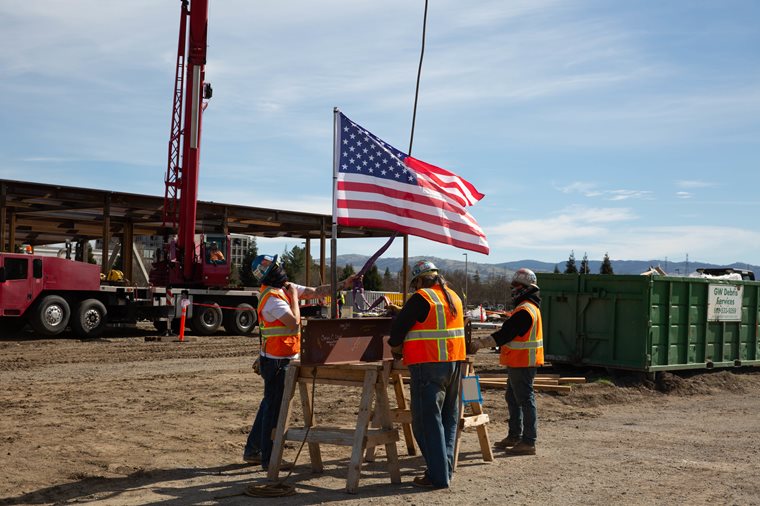A commercial approach to constructing new government-owned facilities is showing promise at a premier U.S. national laboratory by accelerating completion, saving money, and delivering top-of-the-line facilities to enhance safety and national security missions.
That laboratory is Lawrence Livermore National Laboratory in California, managed and operated by the University of California, Bechtel, Amentum, and BWX Technologies under contract to the U.S. National Nuclear Security Administration (NNSA).

Figure 1: A panorama of Lawrence Livermore National Laboratory.
Adding 5 million square feet over 10 years
NNSA has embarked on a plan to build 5 million square feet of modern office and laboratory space over the next 10 years. At Livermore, some facilities are up to 75 years old. They’re mixed in among buildings hosting the world’s most powerful laser, research on nuclear deterrence and energy security, and some of the U.S. government’s fastest supercomputers.
“The infrastructure is critical to the success of the mission,” said Cynthia Rivera, LLNL principal associate director for Operations and Business. “We have facilities that date back to when the site was a Naval Air Station the 1940s and we have facilities that are new. We are focusing now on modernizing, recapitalizing, and building new. Thanks to the successes that we’ve had over the last few years with our capital construction projects, we have positive momentum.”
In 2019, NNSA selected the new LLNL Emergency Operations Center (EOC) project to be part of a pilot program to prove the concept of streamlined delivery of non-nuclear construction projects between $20M and $50M. The new LLNL EOC will provide 24-hour emergency management operations.
Under budget and ahead of schedule
From Sept 2020 to Feb 2021, the 20,500-square-foot building site has transitioned from a field to a major steel installation capped by a “topping off ceremony” – the placement of the final piece of major structural steel. In May 2021, the project achieved its 50% completion milestone. The project is on pace for occupancy by December 2022 and operations by May 2023. It’s currently under budget and ahead of schedule.

Figure 2: Construction workers prepare the last piece of structural steel for installation at the new LLNL emergency operations center.
As project manager for the EOC, Joni Weamer described the commercial approaches being used during the NNSA pilot program, designed especially for non-hazardous facilities with an estimated cost of under $50 million.
The approaches include many best practices advocated by the Project Management Institute, a national instruction and accreditation body:
- A modern fixed-price, design-build execution strategy.
- An integrated project team comprised of a project management office execution team, the NNSA Livermore Field Office, and lab functional partners.
- Selection of a low-risk site with few environmental concerns. The project had underground utility locations, surveying, soil sampling, and a geotechnical report completed before issuing a request for proposals.
- A vigorous prequalification process to qualify bidders with experience building essential facilities and a mature design-build program.
- A request for proposals to the qualified teams. Burns & McDonnell was selected to design and build the EOC.
- A mature project management office (PMO) infrastructure execution program that uses commercial processes generated by professionals recently hired from companies that execute commercial work.
- “Phase gates” to validate readiness to move to the next stage in project development.
- Standard building techniques and materials.
“At LLNL, the nuclear projects are executed under a separate program that allows for commercial standards to be used on commercial projects” Weamer said. “Also, on the commercial projects, we are not employing first-of-a-kind technology,” she said, although the EOC will be state-of-the-art.
Coping with COVID-19
The construction subcontractor is using digital tools to cope with the ongoing pandemic.
“The contractor is using a 3-D model to plan social distancing into the schedule for the trade work to efficiently minimize craft congestion during the interior buildout of the building.” Rivera said.
“It had a secondary benefit to make sure craft sequencing was really well coordinated,” Weamer added. “It turned out to be a really good idea.”
“Half the battle is won by picking the right partners,” she continued. “We certainly did and so did our design-build subcontractor. And this is the kind of thing that happens – innovative risk mitigation strategies that benefit the project in multiple ways.”

Figure 3: An artist's rendering of the Emergency Operations Center.
Competing with Silicon Valley
The lab’s location near the vibrant construction environment in the San Francisco Bay Area and Silicon Valley is a benefit and a challenge.
“We have a broad construction subcontracting community here. The Bay Area has a lot of construction going on and we do, too,” Weamer said.
However, she said, “The other side of that coin is that we’re subject to the price escalation in the region. We stay tuned to when Apple gets a big complex completed or when San Francisco has a new high rise going up, because these create swings in the craft movement and availability in the area.”
The lab currently has a portfolio of 105 projects in active execution, from small projects to Congressional line items, with a combined Total Project Cost of nearly $470 million.
Although the NNSA commercial practices pilot is limited to six facilities across its enterprise, commercial techniques and practices are not new at Livermore. They were used on an electrical distribution project that will supply power to the lab’s newest high-performance computers and on a recently completed science facility.
“NNSA also uses a program call STAR (Standardized Acquisition and Recapitalization) that leverages existing designs for new labs and office buildings. We recently built a 24,000 square-foot building as part of the STAR program, and we’ve just received Congressional authorization to build two more in that basic design,” Rivera said. “I’m proud of the team for embracing these methodologies and it’s exciting to see them be successful. It’s so important for us to leverage innovative strategies and initiatives to meet our mission needs.”

